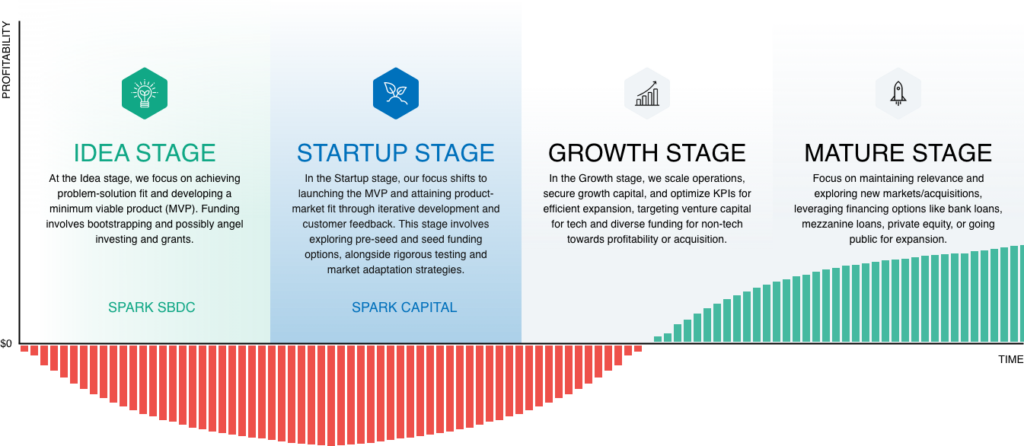
We Can Help You Grow and Scale Your Business
Ann Arbor SPARK can help growth stage companies connect with resources to help you scale. The entrepreneurial services team has multiple programs including affordable office space.

Growth stage: Achieving Business-Model Fit
The growth stage begins when a business has reached product-market fit (PMF) at the end of the startup stage.
The goal of the growth stage is to achieve business-model fit — a repeatable, scalable, profitable business model where the product creates as much value for the company as the customer.
The company gained experience testing the distribution and business models in the startup stage. Now you’ll take it to the next level by raising growth capital, adding talent to the team, optimizing the sales funnel, and tracking key performance indicators (KPIs) — customer acquisition cost, customer lifetime value, conversion rates, churn, revenue growth, etc. — to maximize unit economics and revenue growth.
Company Lifecycle and Funding Sources

Please Note: The company lifecycle graphic is a simplification of capital markets and may not apply perfectly to each company or industry. For example, most angel and venture investors only invest in technology companies, not traditional businesses like restaurants, retail, or real estate.
Tech Small Business Funding
For tech companies, this is where venture capital funds might invest for the first time in a Series A funding round (and subsequent B, C, etc. rounds). Your angel investors from previous rounds may make follow-on investments as well. On average, a Series A round might be $5 – $15 million in investment, primarily to grow the sales and marketing engine to maximize revenue growth. It will likely be an equity round that puts a valuation on the company. Business owners should expect their ownership to be diluted, with Series A investors taking 25 percent ownership or more.
Raising money from venture capital funds is a challenging process that can take up much of a CEO’s time when raising a round. Businesses should learn as much as possible about the fundraising process, how to create a pitch deck, and talk to a venture capitalist. Raising venture capital investment is a process of relationship building and due diligence that can take six months or more.
Fortunately, venture capital investment has grown dramatically in Michigan over the past 20 years. Prior to that, most tech startups had to relocate to the coasts to raise funding. Now there are many angel groups and venture capital funds in Michigan and the Midwest, and many others from the coasts investing in Michigan-based businesses.
In short, technology companies at the growth stage will find many potential investors and lenders:
High-net-worth individuals that invest in startups, often in groups, like the Michigan Angel Fund. Michigan has more than a dozen angel groups and thousands of current or potential angels.
Investment funds that invest in high-growth technology companies with the potential to provide a return of investment that is 10 times or greater in five to seven years. Most companies will not be a fit for venture capital funds, which typically invest in only one to two percent of deals they see.
Lending institutions with expertise in technology companies that often provide financing through innovative structures like venture debt and revenue-based funding.
Spark Resources
SPARK can help educate you on the investment process and potentially connect you with investors in our network. In addition:
(MVCA) publishes an annual Michigan Entrepreneurial & Investment Landscape Guide with information and contacts for many of the angel and venture capital groups in the region.
Based in Ann Arbor, offers free fundraising consulting to startups.
Non-Tech Small Businesses Funding
Non-tech small businesses in the growth stage won’t typically attract VC, which mainly invests in high-growth tech companies. However, if you are profitable or nearing profitability you may qualify for microloan or bank financing and various forms of growth funding, like growth equity, private equity, and mezzanine debt. The list includes:
Small business loans, often under $50,000, sometimes government-backed, as with SBA and CDFI microloans, and some through non-profit lenders like Kiva.
Profitable companies might be eligible for support from Michigan Economic Development Corporation’s (MEDC) loan enhancement programs, making it possible to get traditional bank financing that’s otherwise unavailable.
Profitable small businesses might pursue a loan backed by the U.S. Small Business Administration, which works with banking institutions to provide financing that would otherwise be unavailable.
Available to profitable companies with hard assets when traditional bank loans may not be. Interest rates will likely be higher than traditional bank loans.
Unsecured (meaning no collateral) loans used for growth, based exclusively on the cash flow of the business, with interest rates ranging 12-20 percent and equity kickers usually in the form of warrants. While more expensive than traditional bank loans, mezzanine funding is cheaper than equity and less dilutive to business owners.
Institutional investors that typically invest in larger companies, often taking a majority stake (buyout) and working actively within the company to increase profitable growth, and seeking to exit the business within a few years at an above-market return. Typically invest in more traditional industries, but invest in larger tech companies as well.
Available to profitable companies, banks lend on the basis of a company’s cash flow and collateral position.
This list offers a wide range of funders that may or may not be a fit depending on multiple factors. SPARK can help guide you to appropriate funders and resources. We invite you to complete our funding resources questionnaire.
The Path to Exit

Tech companies and some traditional businesses that successfully scale during the growth stage become acquisition targets for larger businesses, providing the opportunity for founders and investors to exit and get a significant return on investment. But sometimes they will continue to grow on their own and might even do an initial public offering (IPO) to raise additional growth funds. Read about mature-stage businesses for more information.
Share Your Business Idea
It all starts with an idea. Become a SPARK client to access grants, work with mentors, and more.
Contact the Capital Programs Team
Connect with the experts to learn more about raising capital or if you’re interested in supporting startups by becoming an angel investor.